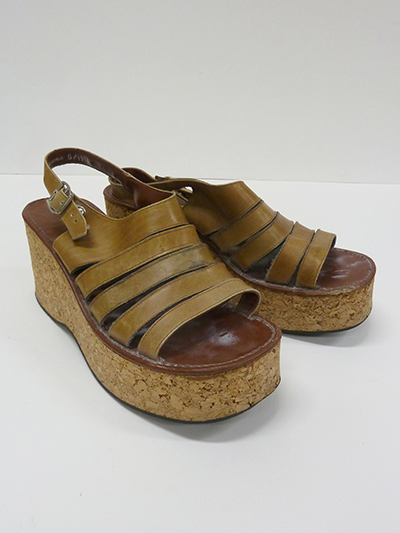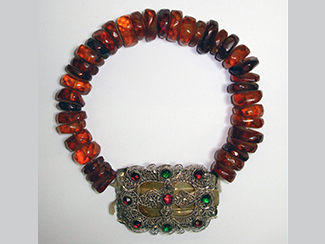FLORA AND FASHION: MISCELLANEOUS: WOOD, BARK, CORK, RUBBER, AMBER, GRASS, BAMBOO, HUSKS, NUTS, DYES
By Nicole Johnston and Jean Parsons
September 20, 2018
A variety of other natural plant materials are used to make apparel, textiles and accessories. These include wood, bark, cork, rubber, amber, grass, bamboo, husks, and nuts. Some of these plants are used in their natural state while others are processed into other forms.









BARK CLOTH, the oldest known textile fiber, was once common in Asia, Indonesia, Africa and the Pacific. Named a World Heritage Textile by the United Nations Educational, Scientific, and Cultural Organization (UNESCO), it is still produced in Uganda, primarily from the Moraceae tree family. Tapa cloth, made historically from the dye-fig (Ficus tinctoria) as well as from the paper mulberry tree (Broussonetia papyrifera), was traditionally used for clothing throughout the Pacific and remains culturally important in the region and in Indonesia. Bark cloth is formed by beating and stretching strips of the fibrous inner bark into sheets which are often stamped or stenciled then finished into a variety of wearable items. Bark cloth is a sustainable textile as the bark of the tree regenerates and can be harvested repeatedly over dozens of years.






CORK is a wood product harvested for commercial use primarily from Qeurcus suber (cork oak), which is native to southwest Europe and northwest Africa. Its impermeability and buoyancy enable it to be used in a variety of products including footwear, fashion accessories, sports equipment, floor, wall and ceiling coverings, insulation, and wine stoppers. To obtain cork, the bark is stripped from the tree approximately every nine years, making cork production fairly sustainable as the tree is not cut down.



NATURAL RUBBER is harvested from a variety of plant species, the most significant source being a tree native to the tropical Americas known as Hevea brasiliensis. The sticky, milky latex sap is tapped from the tree and refined for commercial processing. Charles Goodyear improved the refining process in 1839 with the invention of vulcanized rubber that was unaffected by hot, cold or moist weather conditions, and was resistant to water and chemical interactions. Natural rubber is used in many applications including tires, gloves, balloons, erasers, tubes, and swim and military accessories. Today, most of the world’s natural rubber is obtained from rubber plantations in Malaysia, Thailand and Indonesia.(14)








Natural rubber can be manipulated into a filament and combined with other fibers. The fibers can then be woven or knitted into a stretch fabric. In 1820 Thomas Hancock patented elastic fastenings for gloves, suspenders, shoes and stockings. It was also used in the form of looped stretch bands patented by Stephen Perry in 1845 and in women’s support undergarments like brassieres and girdles. Natural rubber was the core of Lastex, a type of elastic yarn introduced in the 1930s primarily used for swimwear and women’s support garments such as girdles and brassieres. Lastex yarn was formed using an extruded rubber filament wrapped in double layers of wool, rayon or silk.(7) This extruded rubber had a strength approximately three times that of cut rubber and was more resistant to oxidation and chafing.(8)


AMBER is fossilized pine tree resin. During the process of polymerization, the sticky, viscous discharge hardens and fossilizes over many centuries. Valued for millennia as a gemstone, amber is made into a variety of decorative objects, including jewelry. Most amber is acquired through mining and then lathed and polished. Friction with flannel can provide a final luster. Amber is often imitated using a variety of celluloids, resins and glass.(6)



BAMBOO is one of the fastest-growing plants in the world, capable of growing nearly four feet in a single day. Bamboo stalks are used for accessories such as sunglasses and umbrella and purse handles. To create bamboo fiber, the raw pulp is transformed using significant natural and synthetic resources including solvents such as sulfuric acid or sodium hydroxide, both of which are dangerous to animals. Half of all chemicals used end up in the environment either through air emissions or wastewater.(2)



CORN husks are the leafy outer coatings of an ear of maize (corn) that are usually considered a byproduct of corn harvesting. Native to the Americas, corn was first cultivated in Central America over 7,000 years ago and today, is the most widely grown crop in the western hemisphere.(30) Corn husks were and are used by Native Americans, and later by European settlers and African slaves, to craft dolls, baskets, and more. During the early 20th century interest arose once again in the use of corn husks.
KUKUI NUTS (also known as candlenuts) are harvested from the kukui tree (aleurites moluccanus) whose bark was traditionally used by Hawaiians as a dye for textiles. Designated the state tree of Hawaii in 1959, the kukui tree produces irregularly-shaped, hollow nuts that are frequently used in jewelry. The tree’s leaves are also used to make leis. TAGUA NUTS, often referred to as vegetable ivory due to its similarity to animal ivory, are made from the very hard white tissue of the seeds of certain types of palm trees found in South America, the Caroline Islands, Solomon Islands, and in Sub-Saharan Africa. Tagua nuts are also used to make buttons, dice, knife handles, chess pieces, and artistic carvings.


The apparel industry utilizes both natural and synthetic DYES. The majority of natural dyes are derived from plant sources such as roots, berries, leaves, wood, bark, fungi and lichen, as well as from a variety of insects and mollusks. A few of the most historically common plant dyes include indigo, saffron, madder and woad. Challenges to using natural dyes include limited and inconsistent hues and intensity, as well as labor intensive processing of plant matter to acquire dyes. Most dyes used today are synthetic, made from petroleum by-products, chemicals and earth minerals, and must be assisted by other chemical agents to ensure colorfastness. Mauvine was the first synthetic aniline dye discovered accidentally by William Henry Perkin in 1856. This discovery sparked an international race to produce other synthetic dyes that could be manufactured on an industrial scale. Blue indigo dye was synthesized in 1880 but it was not until 1897 that the German dye company BASF produced a viable industrial product.(34)
The late 19th and early 20th centuries saw a resurgence of natural dye use as part of the Arts and Crafts movement which advocated reform to improve standards of decorative design debased by mass manufacturing. Many of the movement’s textile and print artists and designers including William Morris, Lindsay Butterfield, Mackay Hugh Baillie Scott, William Baumgarten, and Lorentz Kleiser frequently utilized natural dyes in the creation of their decorative art objects.



Dyestuffs are often discharged during the manufacturing process and end up in waste water, on workers, and in the air. “Dye wastewater is considered to be one of the most harmful effluents, being carcinogenic to human and aquatic life.”(35) Synthetic indigo, for example, uses aniline, a Category 2 carcinogen, for increased water solubility. However, up to one-third of synthetic indigo dye remains on the cotton denim while the remaining chemicals escape during the dyeing process.(11) Dye wastewater can also “restrict sunlight penetration in contaminated water bodies” and “long persistence of dye in water bodies leads to increased chemical oxidation demand and causes foul odor” (35) Efforts to reduce and/or remove contaminants from water and wastewater include experiments with sorbents such as jute, castor seed shell, potato, bacteria, and alum sludge.
SOURCES
(2) Kadolph, Sara J. Textiles, 10th Edition. New Jersey: Pearson Education Inc. 2007.
(6) https://en.wikisource.org/wiki/1911_Encyclop%C3%A6dia_Britannica/Amber_(resin)
(7) Farrell-Beck, Jane; Gau, Colleen (2002). Uplift: The Bra in America. University of Pennsylvania Press. pp. 62–63. ISBN 0812218353.
(8) (1935) LASTEX YARN, Journal of the Textile Institute Proceedings, 26:3, P40-P41, DOI: 10.1080/19447013508662205
(9) Hardin, Ian R., Susan S. Wilson, Renuka Dhandapani, and Vikram Dhende. An Assessment for the Validity of Claims for “Bamboo Fiber.” (2009) University of Georgia.
(10) Munjal, Kalpana and Radha Kashyap. “Bamboo Fiber: An Approach Toward Sustainable Development.” International Journal of Science and Research(2013) https://pdfs.semanticscholar.org/b473/0223675d9dab54b7260c3898f57345fac153.pdf Retrieved August 6, 2019.
(11) https://cen.acs.org/business/consumer-products/new-textile-dyeing-methods-make/96/i29. Retrieved August 6, 2019.
(14) http://www.industrialrubbergoods.com/natural-rubber.html
(15) “Palm Fiber.” Transport Information Service. http://www.tis-gdv.de/tis_e/ware/fasern/palmfase/palmfase.htm. Retrieved June 2019.
(16) https://www.wisconsinhistory.org/Records/article/CS2643
(18) Knight, Virginia. “The Answer to Laundry in Outer Space” The Rise and Fall of the Paper Dress in 1960s American Fashion https://libres.uncg.edu/ir/unca/f/V_Knight_Answer_2014.pdf
(19) George R. Bridges, letter to Robert Bayer, October 10, 1966. Robert & Audrey Bayer Paper Clothing Collection, OS2007.12.01,Folder BAY017. Special Collections at Ramsey Library, University of North Carolina Asheville.
(20) Progress Report for April-June 1967, Tennessee Valley Authority, Division of Forestry Development. Robert & Audrey Bayer Paper Clothing Collection, OS2007.12.01,Folder BAY006. Special Collections at Ramsey Library, University of North Carolina Asheville.
(30) Hilaire, Larry. “Corn: An American Native.” Spanning the Gap. Delaware Water Gap National Recreation Area Newsletter, U.S. Department of the Interior National Park Service. Vol 22, No 1 (Spring 2000) https://www.nps.gov/dewa/learn/nature/upload/cmsstgCORN.pdf
(34) The Birth of (Synthetic) Dyeing. https://www.open.edu/openlearn/history-the-arts/history/history-science-technology-and-medicine/history-science/the-birth-synthetic-dyeing. September 2007. Retrieved 9.5.2019.
(35) Ghodke, Shailesh A., Shirish H. Sonawane, Bhaat A. Bhanvase, and Irina Potoroko. “Advanced Engineered Nanomaterials for the Treatment of Wastewater.” Handbook of Nanomaterials for Industrial Applications. 2018, pages 959-970. https://www.sciencedirect.com/science/article/pii/B9780128133514000559?via%3Dihub